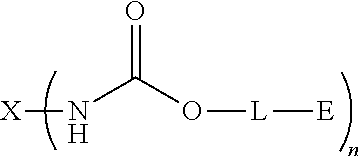Modified calcium carbonate-filled adhesive compositions and methods for use thereof
a technology of modified calcium carbonate and composition, which is applied in the field of thermosetting compositions containing modified calcium carbonate, can solve the problems that adhesives containing only silica fillers do not reflect light well, and achieve excellent rheological properties, less abrasive, and inherent softness of calcium carbona
- Summary
- Abstract
- Description
- Claims
- Application Information
AI Technical Summary
Benefits of technology
Problems solved by technology
Method used
Image
Examples
example 1
[0067]The above bi-functional compound: 11-maleimidoundecanoic acid was prepared according to the following procedure: A two liter flask was charged with 61.25 grams (0.625 moles) maleic anhydride, 500 grams toluene, and 100 grams N-methylpyrrolidone (NMP). This mixture was stirred magnetically until all of the anhydride had dissolved and 100.5 grams (0.5 mole) of 11-aminoundecanoic acid was then added to this solution over the course of five minutes. The mixture was then stirred at 50-60° C. for one hour to fully form the maleamic acid. Twenty grams of methane sulfonic acid (MSA) was added to the mixture. The flask was equipped with a Dean Stark trap and condenser and then refluxed overnight. A total of 9.8 mLs water was collected (theoretical=9.0). The mixture was then cooled to room temperature and then placed in a two-liter separatory funnel and washed with twice with 200 mL deionized water to remove the NMP and MSA. The toluene phase was transferred to a two-liter round-bottom ...
example 2
[0068]A 500 mL single neck flask was charged with 50.0 grams “Socal 31” (a precipitated, rhombohedral, high surface area, calcium carbonate powder from Solvay Advanced Functional Minerals), 2.5 grams 11-maleimidoundecanoic acid, 250 mL acetone, and a magnetic stir bar. A bubbler was attached and the mix was stirred at room temperature. Reaction between the acid and filler was evidenced by the evolution of carbon dioxide. The generation of carbon dioxide had ceased after twenty-four hours. The mixture was poured into a large stainless steel pan and the acetone was evaporated off. The solids were then further dried at 100° C. for four hours in an oven.
example 3
[0069]A one-liter single-neck flask was charged with 100 grams Socal 31, 400 mL acetone, 3.0 grams 4-hydroxybenzoic acid, and a stir bar. A bubbler was attached to monitor the evolution of carbon dioxide. This mixture was stirred for thirty-six hours and then the modified calcium carbonate was recovered as described in example 2.
PUM
| Property | Measurement | Unit |
|---|---|---|
| temperature | aaaaa | aaaaa |
| temperature | aaaaa | aaaaa |
| temperature | aaaaa | aaaaa |
Abstract
Description
Claims
Application Information
 Login to View More
Login to View More - R&D
- Intellectual Property
- Life Sciences
- Materials
- Tech Scout
- Unparalleled Data Quality
- Higher Quality Content
- 60% Fewer Hallucinations
Browse by: Latest US Patents, China's latest patents, Technical Efficacy Thesaurus, Application Domain, Technology Topic, Popular Technical Reports.
© 2025 PatSnap. All rights reserved.Legal|Privacy policy|Modern Slavery Act Transparency Statement|Sitemap|About US| Contact US: help@patsnap.com



